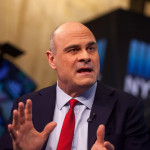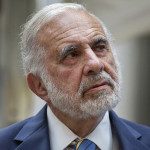

News that activist investor Carl Icahn has his eye on a company must make any chief executive officer feel a bit like a water buffalo that has suddenly realized it is being tracked by a hungry lion. So it’s worth noting that American International Group’s Peter Hancock appears — at least for now — to have accomplished the impressive feat of taming the ferocious beast in a manner that did not involve being eaten alive.
When Icahn roared onto the scene late last year along with fellow hunter John Paulson to demand a breakup of AIG, fixed-income investors were clearly spooked. Spreads on the company’s bond yields above Treasuries blew out well above those of peers on the notion that the activists had a shot at succeeding in the goal of chewing the insurance company into three parts, which would result in a smaller, less-diverse company whose debt, ergo, would be riskier.
Now the yield spreads tell a different story, as Bloomberg Intelligence credit analyst Ryan O’Connell wrote in a report on Tuesday. The spreads signal that a breakup of AIG appears less likely.

For fans of mixed metaphors, you could look at this as a prize fight that’s ended in a draw. Hancock achieved his main goal of preventing a sudden drastic breakup of the company that was demanded to free up regulatory capital required of a systemically important financial institution. Icahn and Paulson won board seats and other concessions. Last week, AIG’s mortgage insurer, United Guaranty, filed for an initial public offering under a plan announced in January to sell up to 19.9 percent of the business in the first step to a full separation. AIG cut Hancock’s short-term incentive pay for last year by 29 percent as the company missed profit targets. Some of the firm’s highest-paid executives have announced their departures. Also, AIG stopped using credit default swaps as an input in setting Hancock’s pay, a link to creditworthiness that Icahn had warned would reduce the CEO’s incentive to break up the company. CDS prices on AIG had soared to a three-year high amid Icahn’s campaign:

Has Hancock managed to fully domesticate the king of the jungle? That’s hard to say for sure. Part of his plan is to return $25 billion to shareholders through 2017, and AIG will have to improve performance in its property and casualty insurance to reach that goal, according to Bloomberg Intelligence. We’ll get an update on the progress when the company reports earnings next month.
Still, the last we heard from Icahn, he went from roaring like a ferocious lion to purring like a kitten.
“We commend the board for adopting a number of our recommendations over the last few months,” Icahn wrote on his website in February. “I hope and believe that we will work with AIG’s board to enhance value as we have done with so many other boards and companies in the past.”So it looks as if Hancock can take a bow for now. But as any lion tamer will tell you, he’ll need to keep watching his back — and probably keep his head out of the lion’s mouth.
This column does not necessarily reflect the opinion of Bloomberg LP and its owners.